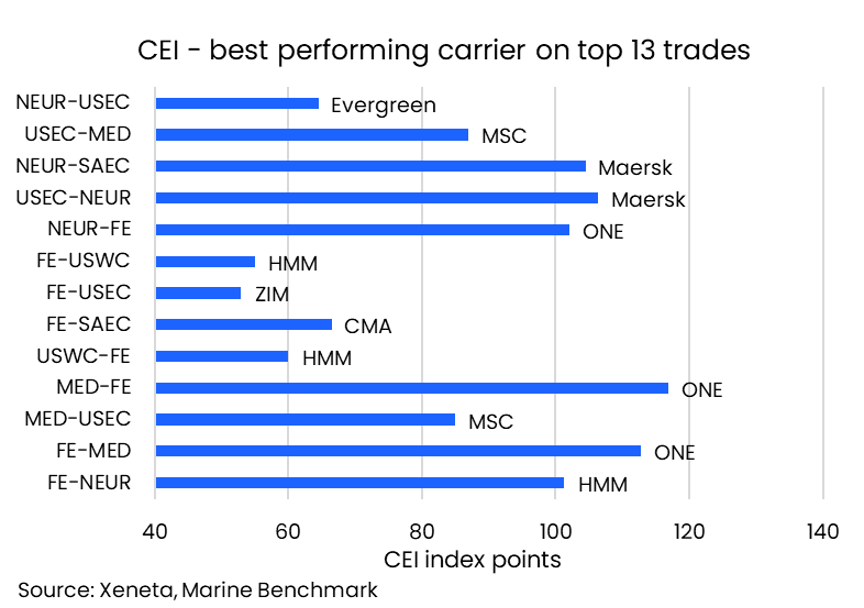Archives
Business, Feature, Freight News, Sea
Boxship Emissions Set Record, Xeneta
[ November 1, 2024 // Gary G Burrows ]Global ocean container supply chains experienced record-high carbon emission in the third quarter of 2024, due to the ongoing impact of conflict in the Red Sea, spiraling freight rates and congestion, according to Xeneta, the ocean and air freight rate benchmarking and market analytics platform.
Xeneta’s Marine Benchmark Carbon Emissions Index, or CEI, which measures carbon emissions across the platform’s top 13 ocean container shipping trades, hit 107.9 points in Q3, which was up 12.2 percent compared to a year ago before the Red Sea crisis (see “Average CEI on Top 13 Trades”).
The CEI is based on the first quarter 2018, meaning any reading above 100 indicates carbon emissions per tonne of cargo carried are above levels from that period. Third quarter 2024 is only the second time the 100-point mark has been breached, with the first time being the first quarter earlier this year, in the immediate aftermath of escalation in the Red Sea.
Six of the 13 trades were below the 100-point benchmark for the most recent quarter – indicating a lowering of emissions per tonne of cargo carried compared to Q1-2018 base.
Red Sea Impacts
The Red Sea crisis’ effect on the CEI is most clearly seen in a year-on-year comparison, with the four trades most impacted by diversions around the Cape of Hope seeing emissions increase by more than 30 percent in third quarter compared to Q3-2023 (the two front-hauls and two backhauls connecting the Far East with North Europe and Mediterranean).
The biggest year-on-year increase is found on the Far East to Mediterranean trade, up 60.1 percent, while the backhaul is up 46.3 percent. (The trade from North Europe to South America East Coast has also seen a year-on-year CEI increase of more than 30 percent in third quarter, despite not transiting the Red Sea and Suez Canal).
Conversely, five trades have seen lower emissions compared to the third quarter last year – and unsurprisingly these are trades not impacted by longer sailing distances around Africa. The backhaul from the U.S. East Coast to the Mediterranean has seen the biggest year-on-year drop, 26.5 percent.
Comparing the third quarter with the second quarter provides insight into the evolving impact of the Red Sea conflict on the CEI during 2024.
Emissions on the fronthaul from the Far East to Mediterranean (the trade with the biggest year-on-year increase) fell 3.5 percent from the second quarter to 140.6 points (the backhaul increased a further 10 percent in the third quarter to 164.3 points).
The biggest quarter-on-quarter increases were on backhaul trades unimpacted by the Red Sea diversion, with emissions increasing 40.3 percent from the U.S. West Coast to Far East and 19.7 percent from the U.S. East Coast to North Europe.
Emission Omission
The deterioration on the transatlantic backhaul is partly due to a 1,250-TEU decrease in the average capacity of ships deployed on this trade, with smaller ships being less efficient when it comes to carbon emissions, according to Xeneta.
Higher emissions on backhaul trades is due to carriers increasing speed to rush their ships back for their next scheduled sailing. Several trades have seen average sailing speed reach multi-year highs.
Reducing carbon emissions falls down the priority list at times of increasing congestion, tightening capacity and spiraling freight rates. When shippers are scrambling to secure capacity and carriers are financially incentivized to provide it, carbon reduction is not front of mind for either party.
Falling filling factors is also leading to higher emissions per tonne of cargo carried. This is largely due to a deteriorating trade balance, with exports from Europe and U.S. back to the Far East growing at a much slower rate than volumes on the fronthaul leg. In the first eight months of the year, Far East to Europe volumes rose 7.7 percent compared to an increase of just 0.3 percent the other way. And though exports from North America to the Far East have performed better, up 7 percent, this is still considerably lower than the 17.7 percent increase on the fronthaul.
Looking across the top 13 trades, ONE and HMM take top spot as best performing carrier on three trades (see “CEI – Best Performing Carriers”). Only COSCO, Hapag-Lloyd and Yang Ming failed to take top spot on any of the top 13 trades.

Tags: Carbon Emissions Index, Xeneta











